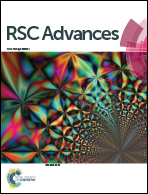Copper–CNT interfacing with Cu-doped polydopamine in CNT carpet: copper nucleation and resistance decrease upon soft annealing
Abstract
In recent years, Cu–CNT composites have attracted much attention due to their remarkable properties, in comparison to pure copper, such as higher ampacity and a lower thermal coefficient of resistance. However, the fabrication of an efficient Cu–CNT composite is still challenging, mainly due to the high cuprophobicity of CNTs. To strengthen the chemical interactions between Cu and CNTs, we propose using a Cu-doped polydopamine coating as an interface between CNTs and metallic copper. This work reports on the nucleation of copper particles on the surface of MWCNTs that are coated with Cu-doped polydopamine after annealing in an inert atmosphere at 573, 673 and 773 K. We show, for the first time to the best of our knowledge, that the polydopamine coating oxidizes during annealing and efficiently reduces Cu ions into metallic Cu. Interestingly, the sheet resistance of coated CNT carpets can be reduced by 33 and 37.6% after annealing at 573 and 773 K, respectively. Furthermore, the sheet resistance decrease does not depend on the size of copper particles (diameter ranging from 13 to 27 nm) or their surface density (from 2.27 × 1010 to 5.7 × 108 particles per cm2). This sheet resistance drop is mainly attributed to the appearance of pyridinic nitrogen in the Cu-doped polydopamine structure after annealing at 673 K and above. Finally, we measure a negative temperature coefficient of resistance for all of the CNT carpets.



 Please wait while we load your content...
Please wait while we load your content...